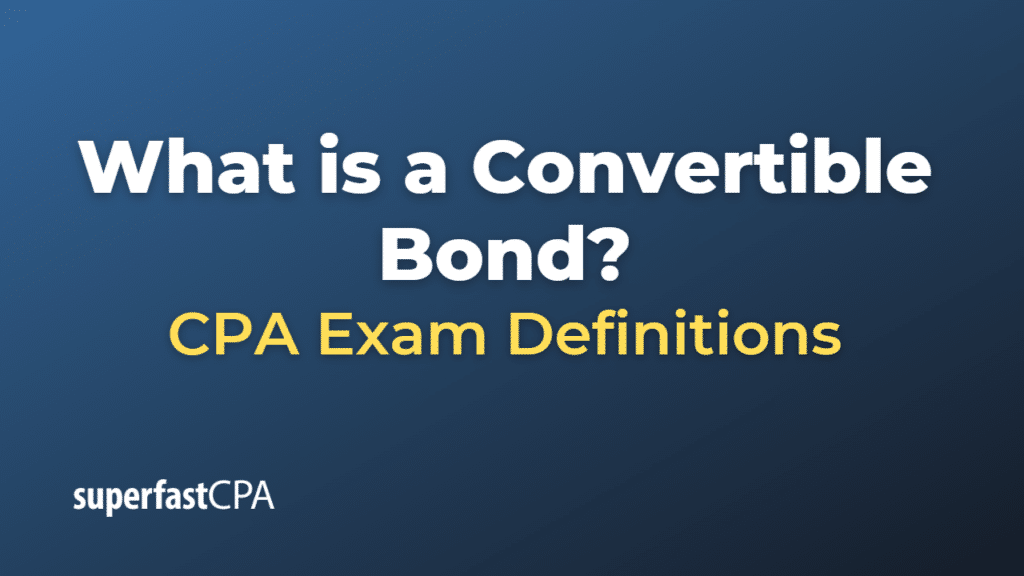Convertible Bond
A convertible bond is a type of debt security issued by a corporation that can be converted into a predetermined number of the company’s common shares at the bondholder’s discretion. Convertible bonds combine features of both bonds and stocks, offering the potential for capital appreciation if the company’s stock price increases while also providing regular interest payments like traditional bonds.
Key features of convertible bonds include:
- Interest Payments: Convertible bonds pay periodic interest (coupon) payments to bondholders, usually at a fixed rate and on a semi-annual basis. The interest rate on convertible bonds is typically lower than that of non-convertible bonds, as the conversion feature offers the potential for capital gains if the company’s stock price rises.
- Maturity Date: Like traditional bonds, convertible bonds have a maturity date at which the principal amount is repaid to bondholders if the bond has not been converted into common shares.
- Conversion Feature: The most distinguishing feature of a convertible bond is the option for bondholders to convert their bonds into common shares of the issuing company. The conversion ratio, which specifies the number of shares that can be obtained upon conversion, is predetermined at the time of issuance.
- Conversion Price: The conversion price is the predetermined price at which the bond can be converted into common shares. It is usually set at a premium to the market price of the shares at the time of issuance to incentivize investors to hold the bond and receive interest payments.
Convertible bonds are attractive to investors because they offer the potential for capital appreciation if the company’s stock price increases, while also providing downside protection through regular interest payments and the return of principal at maturity. For issuing companies, convertible bonds can be a cost-effective way of raising capital, as the interest rates on convertible bonds are typically lower than those on non-convertible debt due to the conversion feature.
Example of a Convertible Bond
Let’s consider a hypothetical example to illustrate how a convertible bond works:
Company XYZ decides to raise capital by issuing convertible bonds. Each bond has a par value (face value) of $1,000, an annual interest rate (coupon rate) of 4%, a maturity period of 5 years, and a conversion price of $50 per common share.
- Interest Payments: The convertible bond pays a 4% annual interest on its par value. This means that bondholders will receive $40 (4% of $1,000) in interest payments per bond each year, typically split into two semi-annual payments of $20.
- Maturity Date: The bond has a maturity period of 5 years. If the bondholder does not choose to convert their bond into common shares by the end of this period, they will receive the $1,000 par value of the bond.
- Conversion Feature: The conversion price is set at $50 per share. To determine the conversion ratio, divide the par value by the conversion price:
Conversion Ratio = Par Value / Conversion Price
Conversion Ratio = $1,000 / $50
Conversion Ratio = 20
This means that each convertible bond can be exchanged for 20 common shares of Company XYZ.
Now let’s assume that, after 3 years, Company XYZ’s stock price has risen to $60 per share. A bondholder might decide to convert their bond into common shares, as the value of the shares upon conversion would be higher than the bond’s par value:
Value of Common Shares Upon Conversion = Conversion Ratio × Market Price per Share
Value of Common Shares Upon Conversion = 20 × $60
Value of Common Shares Upon Conversion = $1,200
In this scenario, converting the bond into common shares results in a capital gain for the investor, as the value of the shares ($1,200) is higher than the bond’s par value ($1,000). The bondholder also benefited from the interest payments received during the time they held the bond.
It’s important to note that investors should consider various factors, such as market conditions, interest rates, and their own investment objectives, before deciding whether to hold or convert their convertible bonds.













